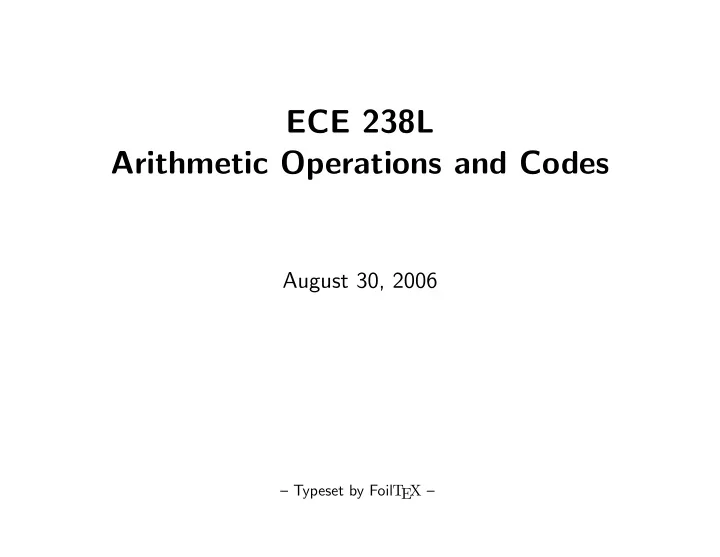

ECE 238L Arithmetic Operations and Codes August 30, 2006 – Typeset by Foil T EX –
Binary Addition 0 + 0 = 0 0 + 1 = 1 1 + 0 = 1 1 + 1 = 0 and carry 1 to the next column. Examples: 1 1 1 0101 0101 5 10 5 10 + 0010 + 0011 2 10 3 10 0111 1000 7 10 8 10 – Typeset by Foil T EX – 1
Binary Addition with Overflow Add 45 10 and 44 10 in binary: 1 11 <------- Carries 101101 (45) + 101100 (44) ---------- 1011001 If the operands are unsigned, you can use the final carry-out as the MSB (Most Significant Bit) of the result. Adding 2 k-bit numbers may result in a k+1 bit result. – Typeset by Foil T EX – 2
More Binary Addition with Overflow 1 1 1 1111 15 10 + 0001 1 10 0000 0 10 If you don’t want a 5-bit result, just keep the lower 4 bits. Four bits are insufficient to hold the result (16). So, it rolls back to 0. – Typeset by Foil T EX – 3
Binary Subtraction Borrows: 00000 00110 Minuend: 10110 10110 Subtrahend: - 10010 - 10011 Difference: 00100 00011 Again the same as decimal. If the subtrahend is larger than the minuend reverse the two operands and put a minus sign on the result. 0110 1000 - 1000 - 0110 → -0010 – Typeset by Foil T EX – 4
Multiplication Multiplicand: 1011 11 Multiplier: 101 5 × × 1011 55 0000 1011 Product: 110111 110111 = 32 + 16 + 4 + 2 + 1 = 55 These same approaches apply to hexadecimal as well as octal, you just need to be more careful with your digits. – Typeset by Foil T EX – 5
Binary Arithmetic • Arithmetic with binary numbers is just like any other numbers – digit-by-digit addition – carries propagate to next column to left • Overflow can occur – keep the extra bits or – just keep k bits (roll-over will occur) – Typeset by Foil T EX – 6
Binary Coded Decimal (BCD) Decimal BCD 0 0000 Convert 2496 10 to BCD code: 1 0001 2 4 9 6 2 0010 ↓ ↓ ↓ ↓ 0010 0100 1001 0110 3 0011 Not this is very different from converting 4 0100 to binary which yields: 5 0101 6 0110 100111000000 2 7 0111 In BCD ... 8 1000 0010010010010110 9 1001 – Typeset by Foil T EX – 7
BCD Addition BCD carry 1 1 448 0100 0100 1000 + 489 + 0100 + 1000 + 1001 937 Binary sum 1001 1101 1 0001 Add 6 + 0110 + 0110 BCD sum 1 0011 1 0111 BCD result 1001 0011 0111 Add each digit. If the result is greater than 9, add 6 and carry any overflow to the next digit. Repeat. – Typeset by Foil T EX – 8
Why BCD? • BCD is common in electronic systems which display numeric values. • Using BCD simplifies manipulation of numerical data for display. • Each digit is a separate subcircuit, which will be true for a 7 segment display. • Binary requires a conversion to decimal to determine the digits. Disadvantages are 1) that addition is more difficult and requires extra circuitry. 10-15%. And 2), using 4 bits to represent 10 values can be expensive. – Typeset by Foil T EX – 9
Binary Codes - ASCII Character ASCII Code c 1 1 0 0 0 1 1 d 1 1 0 0 1 0 0 e 1 1 0 0 1 0 1 f 1 1 0 0 1 1 0 g 1 1 0 0 1 1 1 Convert “help” to ASCII h 1 1 0 1 0 0 0 I 1 1 0 1 0 0 1 h e l p j 1 1 0 1 0 1 0 110100 1100101 1101100 1111000 k 1 1 0 1 0 1 1 l 1 1 0 1 1 0 0 m 1 1 0 1 1 0 1 n 1 1 0 1 1 1 0 o 1 1 0 1 1 1 1 p 1 1 1 0 0 0 0 q 1 1 1 0 0 0 1 – Typeset by Foil T EX – 10
Gray Codes Gray Number Binary Code 0 0000 0000 1 0001 0001 • Only one bit changes with each 2 0010 0011 number increment 3 0011 0010 4 0100 0110 5 0101 0111 6 0110 0101 • Not a weighted code 7 0111 0100 8 1000 1100 9 1001 1101 • Useful for interfacing to some 10 1010 1111 11 1011 1110 physical systems 12 1100 1010 13 1101 1011 14 1110 1001 15 1111 1000 – Typeset by Foil T EX – 11
Gray Codes are Not Unique Gray Gray Number Code Number Code 0 000 0 000 1 001 1 010 2 011 2 110 3 010 3 111 4 110 4 011 5 111 5 001 6 101 6 101 7 100 7 100 – Typeset by Foil T EX – 12
Parity Bits Word Even Parity Odd Parity 1000001 01000001 11000001 1010100 11010100 01010100 Even Parity - number of 1 bits should be even. Odd Parity - number of 1 bits should odd. Parity can detect any number of odd errors: 1,3,5,... Parity is also one of the simplest ways to detect errors. Communication protocols commonly include error detection and even correction. – Typeset by Foil T EX – 13
Codes - Summary • Bits are bits – Modern digital devices represent everything as collections of bits – A computer is one such digital device • You can encode anything with sufficient 1’s and 0’s – Text (ASCII) – Computer programs (C code, assembly code, machine code) – Sound (.wav, .mp3, ...) – Pictures (.jpg, .gif, .tiff) – Typeset by Foil T EX – 14
Recommend
More recommend